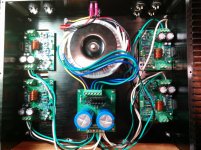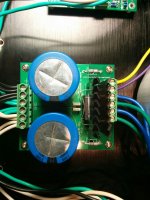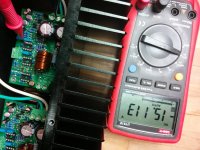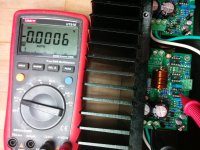all XLR are latching. That's the bit I know with my current information.
No they're not. Parasound uses non-latching XLR connectors. They don't have the release tab and they don't have any sort of spring retention mechanism. This based on my experience with their A23 power amp.
Sometimes you're wrong. This is one of those cases. Bill called you out on it. Was that wrong?
Tom
Last edited:
I found your posts to the "MiniDSP problems" thread at OPLUG and see that you had the Saffire PRO24 prior to building the LXminis. It seems to be less expensive than the miniDSP 4x10 - CAN$399 vs US$499. Are they more or less equivalent? I had understood the 4x10 provided a solution to the 2x4 volume control problem.
MiniDSP keeps the specs tight to the chest, so you don't really know what you get. Some have torn into their units and found a DSP chip by ADI and a couple of mid-fi DACs. It's not bad, but could be better. It's certainly the most turnkey solution available at the moment.
I had the Saffire and spare laptop already, so why spend money on a MiniDSP with unknown performance? The Saffire uses high-end Cirrus DACs. CS4398, I think.
BTW, I take this moment to thank you for Mod86. It has been a pleasure building it. Thanks also to all the contributors to this thread.
You're welcome. I'm glad you enjoyed building it.
Tom
I (and who knows how many others) have a Mackie 1202 mixer with nonlatching XLR inputs. I just made up a hypothesis that because the connectors are on a flat horizontal panel and the connector would plug in vertically, that such a connector would not need a latch, since gravity holds it in place, and that this (horizontal mounting not using a latch) would be a common "standard."
But then I saw this pic:
But then I saw this pic:
Those connectors on the left look exactly like the ones on the Mackie, but they're clearly mounted on a vertical panel, and have nothing but a little friction to keep a cable from being pulled out. Maybe they're made to be non-latching, so they can be connected by people who are used to making RCA connections and don't expect a latch.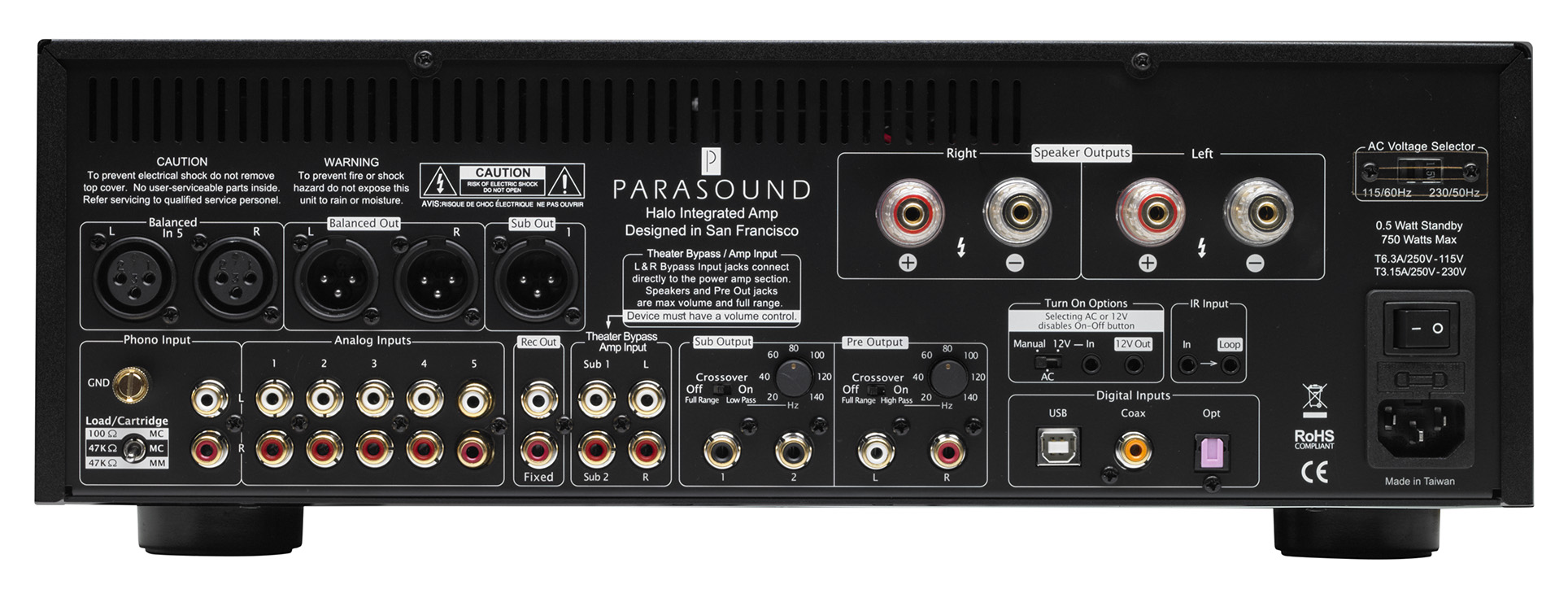
I often strongly disapprove of the abrasiveness of Billshurv's postings, but the word 'gibberish' does come to mind with regard to some peoples contributions,
Benb, it is indeed not a very good solution and I only know about it because StuartY told his boss to buy Parasound, who subsequently complained that the XLR plugs were non-latching and that the heavy cables were coming out.
MiniDSP keeps the specs tight to the chest, so you don't really know what you get. Some have torn into their units and found a DSP chip by ADI and a couple of mid-fi DACs. It's not bad, but could be better. It's certainly the most turnkey solution available at the moment.
I had the Saffire and spare laptop already, so why spend money on a MiniDSP with unknown performance? The Saffire uses high-end Cirrus DACs. CS4398, I think.
You're welcome. I'm glad you enjoyed building it.
Tom
2x8 miniDSP nanoDIGI has volume control. The output is S/PDIF coax only, so you need a stereo DAC for tweeters, and another stereo DAC for woofers.
I paired up some Chinese DAC boards with Tom's THAT Line Driver. I think I lucked out, because the DAC boards were inexpensive, and they sound pretty darn good to me. They're CS4398 also (I think)
Just another option...
AlexQS
If the Saffire 24 is like other Saffires and the Scarletts it'll be CS4272s on non-headphone IO; suggest opening it up for a look.The Saffire uses high-end Cirrus DACs. CS4398, I think.
My guess would be the 4x10 uses a CS42428 codec. That's consistent with the 2x8 and performance specs in the 4x10 datasheet---the -100dB THD, 114dB DnR block Cirrus acquired from Crystal is in widespread use, including the CS4272 and CS42428---but there's substantial difference between MiniDSP quoting results of someone else's work and Focusrite's specifications of real world measured performance including buffers, gain setting, and whatnot.
Beyond that, the question of whether a stack oriented primarily to pro audio recording is equivalent to a solution intended more for consumer oriented set it and forget it playback processing is perhaps most usefully answered with mu as it's an apples and oranges comparison kind of thing which mostly depends on user preferences as to where processing is located. I can point out some potential exists for audible improvement with Reaper over the 4x10 for certain types of low frequency DSP operations. But it's not anything I've ABX tested.
There are a number of parametric equalizers which I think should work. Most of the LV2 implementations I've bumped into, such as fil4.lv2, do happen to support a limited number of bands. Whereas ReaEQ is unlimited per instance. I'm not familiar with Ardour but all EQ in one instance versus multiple instances is normally just a convenience thing.assuming a plugin like ReaEQ is available for Ardour
To the extent thread SnR drops as a result of Andrew's insistence on a frankly bizarre definition of locking, well, probably. To the extent posting misinformation from time to time results in poor design, no. Bill did start this thread so, as far as I'm concerned, it's his call. The current situation is pretty harmless but I'm certainly guilty of calling out Andrew perhaps once a year or two in cases where inadequate or incorrect design practices are being advocated. The internet's not referred to as the contranet for nothing, after all.Bill called you out on it. Was that wrong?
Latches can break, and slow up the break-down
My own experience: I've used snakes where the latches on the XLRs have broken, and they either have to be replaced or taped-off so that cables are not plugged into them. Getting the XLR male out of a broken latch jack is murder!
Also, when one is breaking down after a show, ti is a whole lot faster to just pull out the jacks instead of holding down the latch tab behind a piece of equipment or in a mess of cables obscuring the snake's top panel. YMMV, of course.
Those connectors on the left look exactly like the ones on the Mackie, but they're clearly mounted on a vertical panel, and have nothing but a little friction to keep a cable from being pulled out. Maybe they're made to be non-latching, so they can be connected by people who are used to making RCA connections and don't expect a latch.
My own experience: I've used snakes where the latches on the XLRs have broken, and they either have to be replaced or taped-off so that cables are not plugged into them. Getting the XLR male out of a broken latch jack is murder!
Also, when one is breaking down after a show, ti is a whole lot faster to just pull out the jacks instead of holding down the latch tab behind a piece of equipment or in a mess of cables obscuring the snake's top panel. YMMV, of course.
The Saffire uses high-end Cirrus DACs. CS4398, I think.
According to this Focusrite article conversion performance is dependent on more than the chip. They publish a clock jitter spec. No such discourse from miniDSP.
tomchr said:My only wishlist item is a better volume control in iTunes. The issue is that I can't get the music low enough when the iTunes volume control is a touch above MUTE. I solve it by dialling down the volume in MixControl
The pro24 has two output volume controls, one labeled monitor and one headphone. The volume control on the 4x10 controls all output channels. Is the pro24 any different? It seems that monitors can be plugged into any of the 6 audio outputs.
2x8 miniDSP nanoDIGI has volume control. The output is S/PDIF coax only, so you need a stereo DAC for tweeters, and another stereo DAC for woofers.
As much as I am tempted, with all the unfinished projects on my plate, this is probably not the best route for me at the moment 🙂
I (and who knows how many others) have a Mackie 1202 mixer with nonlatching XLR inputs. I just made up a hypothesis that because the connectors are on a flat horizontal panel and the connector would plug in vertically, that such a connector would not need a latch, since gravity holds it in place, and that this (horizontal mounting not using a latch) would be a common "standard."
Most PA mixers don't have latches for their mic inputs XLR, even the expensive ones. This applies to Mackie, Behringer, Soundcraft, Dynacord, Yamaha, Allen and Heath. And this even when the inputs are horizontal. Mostly, latches would be unpractical for quickly reorganizing your microphones. Latches also fail -always at the worst time- after a number of insertion and a channel's input will see a lot of insertion/removal.
Non latched XLR are also somewhat common on smaller PA speakers made to go on stands: it's better to have the connector unplugged than a speaker falling on someone's head.
Kind of ironic since XLR stands for Cannon X, Latched, Rubber.
Sorry for the OT. In the hifi world, it's harder to see the rationale for non latching xlr, as the system is usually set up once for months.
The pro24 has two output volume controls, one labeled monitor and one headphone. The volume control on the 4x10 controls all output channels. Is the pro24 any different? It seems that monitors can be plugged into any of the 6 audio outputs.
Only two of the rear panel outputs are affected by the monitor volume. The other four are not.
The headphone volume only affects the headphone out on the front panel.
In addition, there's a master volume (and independent channel faders) in the software.
Tom
Woah! Hit the brakes!There are a number of parametric equalizers which I think should work. Most of the LV2 implementations I've bumped into, such as fil4.lv2, do happen to support a limited number of bands. Whereas ReaEQ is unlimited per instance. I'm not familiar with Ardour but all EQ in one instance versus multiple instances is normally just a convenience thing.
Equalizers do not ever perform adequately as a substitute for impedance management. This will not be effective as an argument point, because it is not effective.
Okay, proceed with the row, without that point. . .
So I noticed Mouser and Digi-Key are giving an obsolescence warning on the LME49710NA/NOPB (LTB 9/28/16). TI is pointing towards the OPA227P as an alternative.
So I noticed Mouser and Digi-Key are giving an obsolescence warning on the LME49710NA/NOPB (LTB 9/28/16). TI is pointing towards the OPA227P as an alternative.
Mouser has 2604 of the LME49710NA/NOPB in stock, so right now there should be no issues getting the part.
The LME49710HA (TO-99 package) is a viable alternative. For some reason, TI decided to keep the HA (TO-99) going but discontinue the NA (DIP-08) and MA (SOIC-08). Thankfully, it is possible to fit a TO-99 onto a DIP-08 footprint without having to cross leads.
Once the LME49710NA drifts into obsolescence, I'll have a solution available. The OPA228 would be an interesting option. I'd have to re-spin the compensation, though. That's not a huge deal, but does require some time.
Summary: I'm keenly aware of the lifetime buy. A solution is important but not yet urgent to identify. I will provide a solution.
Tom
So how is it TI is still making it in the tin can, uh, TO-99? I read in the thread on these going obsolete that TI is shutting down the fab where these are made, so I wonder how they're going to supply the chips for this package? Are they just making a big run of chips to store for packaging later? It seems I've heard of that sort of thing being done.
Yeah, I'm not quite buying the fab closure story either. The LM3886 gets to continue but the LM4780 does not. As far as I can tell, the LM4780 is two LM3886es in one package, so that fab story doesn't quite check out either.
The LME49720 gets to continue. I guarantee you it uses the same process as the LME49710. So the process is alive. As are DIP and SOIC packages.
I'm guessing the bean counters decided to do a little pruning in the portfolio and eliminate some package options (LM4780) and the marketing department decided to blame a fab closure.
Maybe enough LME49710s were packaged in TO-99 to provide a lifetime supply. Who knows... 🙂
Tom
The LME49720 gets to continue. I guarantee you it uses the same process as the LME49710. So the process is alive. As are DIP and SOIC packages.
I'm guessing the bean counters decided to do a little pruning in the portfolio and eliminate some package options (LM4780) and the marketing department decided to blame a fab closure.
Maybe enough LME49710s were packaged in TO-99 to provide a lifetime supply. Who knows... 🙂
Tom
You could always use 1/2 lme49720. A soic opamp on a small adapter would easily fit on a dip8 socket.
Hi everbody,
I have just performed the final check as instructed in the design doc and have a bunch of questions. This is my first amp build and am new to all this.
I am building a 4 channel amp. My transformer is an AS-3224. Here are my voltage measurements for number of channels connected:
0 +-35 V
1 +-32 V
2 +-28 V
3 +-22 V
4 +-15 V
I measured the voltage on pins 4 and 7 of U4 with empty U1, U3, and U4 sockets. The first time, with only 1 channel connected, I got -15 V on pin 4 and +15 on pin 7 (I don't believe I was dreaming). Testing the second channel I got +15 V on pin 4 and 0 V on pin 7. I re-tested the first channel again, and this time got 0 V on pin 7. I've tested all channels now with the same results, individually and with 2 and 4 channels connected.
I didn't expect the voltage to drop below +-20 V with 4 channels. Must I change R9, R20, and R22? Can I damage U5 and U6 by not making these changes? Neither are running hot.
What does 0 V on pin 7 indicate? I've inspected the boards and can't find any sign of a short. With 4 channels connected I get a dim glow on a 25 W bulb.
Is this how I'm supposed to connect 4 channels to a Power-86? Is +-15 V enough for my LXminis?
Photos attached.
I have just performed the final check as instructed in the design doc and have a bunch of questions. This is my first amp build and am new to all this.
I am building a 4 channel amp. My transformer is an AS-3224. Here are my voltage measurements for number of channels connected:
0 +-35 V
1 +-32 V
2 +-28 V
3 +-22 V
4 +-15 V
I measured the voltage on pins 4 and 7 of U4 with empty U1, U3, and U4 sockets. The first time, with only 1 channel connected, I got -15 V on pin 4 and +15 on pin 7 (I don't believe I was dreaming). Testing the second channel I got +15 V on pin 4 and 0 V on pin 7. I re-tested the first channel again, and this time got 0 V on pin 7. I've tested all channels now with the same results, individually and with 2 and 4 channels connected.
I didn't expect the voltage to drop below +-20 V with 4 channels. Must I change R9, R20, and R22? Can I damage U5 and U6 by not making these changes? Neither are running hot.
What does 0 V on pin 7 indicate? I've inspected the boards and can't find any sign of a short. With 4 channels connected I get a dim glow on a 25 W bulb.
Is this how I'm supposed to connect 4 channels to a Power-86? Is +-15 V enough for my LXminis?
Photos attached.
Attachments
The transformer is not big enough for 4 channels,. The power board is really intended for 2 channels also. I am not a "plans" owner but there must be on board regulators for the IC chips, the negative regulator is probably dropping out on low voltage supply.
Try with just 2 channels connected.
You will need a further transformer or alternatively a 600VA transformer plus another power board
Try with just 2 channels connected.
You will need a further transformer or alternatively a 600VA transformer plus another power board
Edit,...
I see now where you're measuring. I'm not sure what the reading is supposed to be there, but I think that's where the LME or THAT chip plugs in, and I bet voltage there is supposed to be low. (I think it was around that on Toms THAT I built, there's a voltage regulator or something in front of it). I don't think there's as much voltage drop as you think, just measuring in a different place.
I see your black and white wires, I assume V+ and V- . If you get a reading on one pin, but not the other (pin 7 zero,... Again I'm not sure what it's supposed to be, I assume -15) it possible that the black or white wire insulation on one side is preventing contact with the screws in the green terminal blocks?
I see now where you're measuring. I'm not sure what the reading is supposed to be there, but I think that's where the LME or THAT chip plugs in, and I bet voltage there is supposed to be low. (I think it was around that on Toms THAT I built, there's a voltage regulator or something in front of it). I don't think there's as much voltage drop as you think, just measuring in a different place.
I see your black and white wires, I assume V+ and V- . If you get a reading on one pin, but not the other (pin 7 zero,... Again I'm not sure what it's supposed to be, I assume -15) it possible that the black or white wire insulation on one side is preventing contact with the screws in the green terminal blocks?
Last edited:
I am building a 4 channel amp. My transformer is an AS-3224.
I use the same transformer in my 4-channel build. That's plenty of power for a 4-channel amp intended for music reproduction.
Here are my voltage measurements for number of channels connected:
0 +-35 V
1 +-32 V
2 +-28 V
3 +-22 V
4 +-15 V
That's ***WAY*** too much droop. We need to figure out what's going on there. Each board draws about 50 mA, so expect some droop from the ±35 V, but not 20 V of droop.
One thing I do notice is that the LM3886es aren't mounted on the heat sinks. They just lean against them. You have to drive a screw through the mounting hole in the IC package into the heat sink.
I measured the voltage on pins 4 and 7 of U4 with empty U1, U3, and U4 sockets.
In an older revision of the Design Documentation there was a typo on the pin number. If you measure on the socket for the OPA2277, you need to measure on pin 4 and pin 8. If you measure on the sockets for the LME49710 or the THAT1200, you need to measure on pin 4 and 7. You should still get ±15 V.
If you toss me an email, I'll be happy to send you the latest revision of the design doc.
I didn't expect the voltage to drop below +-20 V with 4 channels. Must I change R9, R20, and R22? Can I damage U5 and U6 by not making these changes? Neither are running hot.
Don't make any changes. We need to find the root cause for why the amps are drawing enough current to cause the supply to droop.
With 4 channels connected I get a dim glow on a 25 W bulb.
Ah! Bulb tester is being used. Awesome. That probably prevented the fuse from popping.
Would you measure the voltage at the amplifier output connector?
Tom
- Home
- Amplifiers
- Chip Amps
- Modulus-86 build thread
